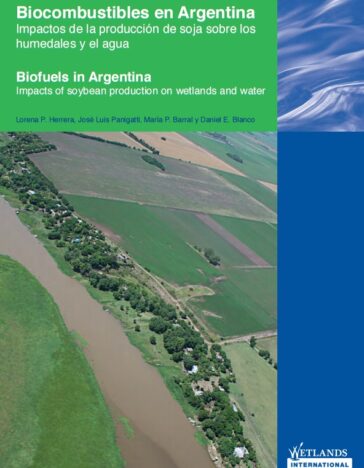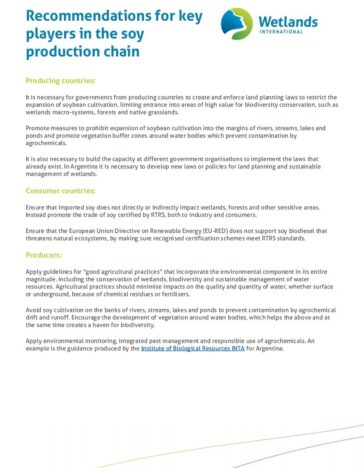Soy and wetlands
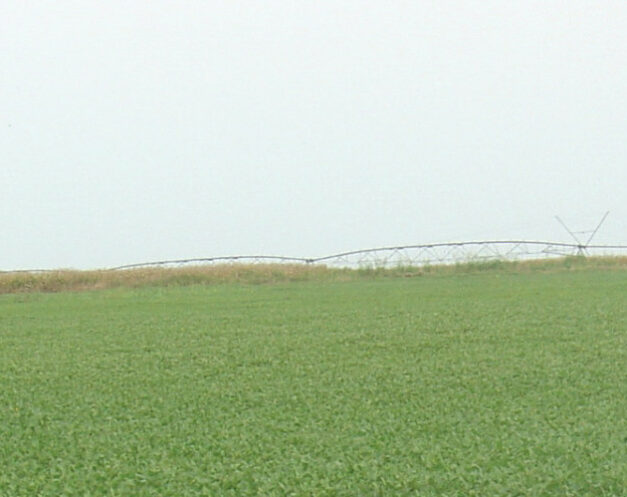
Soy is one of the most important agricultural commodities in the world, used mainly for animal feed fulfilling the meat demands in the world (70%), for biodiesel and for various food products. Soy bean cultivation is increasing at an alarming rate in South America. This has, in the last 15 years, led to monocultures at the expense of key ecosystems like the Atlantic and the Amazon forests, wetlands and grasslands and of areas that were previously used for other purposes such as livestock.
Whilst Wetlands International recognises the values of soy, we believe soy cannot continue to expand unchecked and it is necessary that responsible soy production becomes the common rule, not the exception. Wetlands International therefore works to green the soy industry in South America, for the safeguarding of wetlands and other ecosystems for people and nature.
Impacts of soy on wetlands
In Argentina, Brazil, Paraguay and Bolivia, soy expansion results in wetland loss and degradation. Various wetlands of high conservation status are being affected for this expansion.
This causes the direct loss of biodiversity, but also the loss of key services that these ecosystems provide. Examples of such services include ecological connectivity, the presence of potable water for human consumption, the storage of organic soil carbon, forage production for livestock, and providing sources of income for local people.
Furthermore, the application of agrochemicals for soy cultivation in key wetland areas results in water pollution with serious consequences for biodiversity and aquatic life. Also, human health is threatened in some places.
How are wetlands impacted by soy?
In Argentina, Brazil, Paraguay and Bolivia, soy expansion results in wetland loss and degradation.
We identify the following impacts on wetlands:
- Loss and degradation of wetlands: For the conversion of land for agricultural use, many wetlands are being drained. In parts of the Cordoba province for instance, wetland loss has reached 42% due to drainage. In Bañados del Rio Saladillo, no less than 69% of wetlands surface and 20% of the lagoons has disappeared. Important wetland ecosystem services are lost.
- Soil health: The increasingly intensified agricultural management, dominated by soybean production, leads to soil erosion and associated sediment deposition in low areas, streams or other water runoff pathways. The loss of ground cover results in loss of biodiversity and changes in water balance. The high rate of deforestation in northern Argentina for instance affects wetlands in areas near or even distant from the source of the problem. Furthermore, soil compaction due to the use of heavy equipment, reduces water infiltration and can lead to run-off of nutrients.
- Water use: There is evidence that the inadequate and excessive use of agrochemicals, such as pesticides, herbicides and fertilizers can bring a high risk of water contamination. This can seriously affect water quality, wildlife and fisheries, ultimately affecting local communities and their sources of income, such as traditional fisheries and beekeeping. People close to wetland areas can also be directly affected through drinking or using contaminated water. This is also a problem in areas where wetlands are important in groundwater replenishment.
- Flora and fauna: Agrochemical pollution has effects on the number of many aquatic and amphibian species generating physiological and behavioural changes that changes the relations of the food web. This directly affects the functioning of the ecosystem, and ultimately the goods and services that wetlands provide to humans. When drained wetlands are lost or degraded breeding and nesting sites are lost.
- Indirect land use change: Traditional land use is pushed to other areas, such as wetlands, due to the expansion of soy cultivation. Read the story on what happened in 2008 to the Parana Delta to where around one million cows were displaced from the surrounding Argentina Pampas.
The case of Argentina
In Argentina, soybean currently accounts for over 60% of the cultivated area of the country and is the main crop for biodiesel production, making Argentina the world’s fourth largest producer of biofuels and the largest exporter. The distribution of soybean cultivation areas largely overlaps with wetland distribution. Soy covers mainly the central-eastern region of the country north of Patagonia, overlapping with the highest concentration and area of wetlands in the country. The overlap is in particular large with wetlands located in the Chaco and Pampas regions; to a lesser extent with La Plata Basin and only marginally in the north of Patagonia.
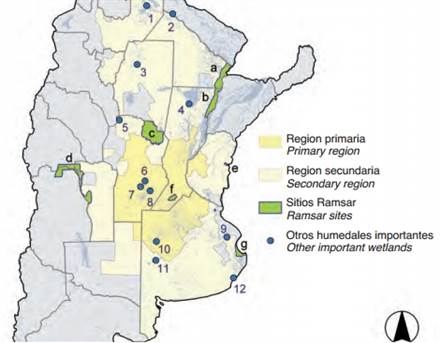
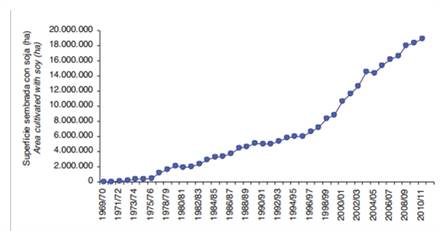
The expansion of soybean cultivation has resulted in moderate to high impacts on wetlands for some areas of the soybean production region, mainly due to land reclamation for agricultural use. This is evident in the southeast of Córdoba province and around the Albufera Mar Chiquita in the province of Buenos Aires, with up to 40% reduction in the area of wetlands. In the case of the Bañados de Saladillo reclamation resulted in system degradation and connectivity loss.
Biodiversity loss in wetlands has been reported in southern Córdoba and it is possible that the same process is happening in other sectors of the soybean production region. In other cases, it has been documented that wetlands loss has led to direct loss of ecosystem services of local and regional importance. In the case of the Parana Delta, farming intensification as a direct consequence of the expansion of soybean, affected traditional farming practices, resulting in the large fires in 2008, which burned 207,000 ha.
Further reading on soy cultivation and wetlands in Argentina:
What can we do about it?
Faced with the advance of soybean along with its associated impacts, it is necessary to identify the mechanisms and tools to promote wetlands conservation and maintenance of water. Despite the availability of technology for higher crop yields and quality with lower environmental impacts, the lack of planning and economic interest leads to crop management with little to no attention to conservation of natural resources, especially wetlands.
Responsible soy production
Soy cannot continue to expand unchecked – limits and standards must be set. It is necessary that responsible soy production becomes the common rule, not the exception. We need to increase demand for soy from responsible suppliers. There has been significant advance with the definition of responsible soy production.
The Round Table on Responsible Soy (RTRS) set standards for Responsible Soy production that includes for example requirements to halt conversion of areas with high conservation value, to promote best management practices, to ensure fair working conditions, and to respect land tenure claims. Now it is necessary to move toward their complete implementation and, in parallel, the evaluation of the standards’ effectiveness.
Mitigating the impacts from soy on wetlands
- Ban soy cultivation in wetland ecosystems that are most sensitive and fragile. This includes areas of high value for biodiversity conservation and along the periphery of rivers, streams, lakes and ponds.
- In landscapes with wetlands, undertake soybean cultivation with appropriate care in order to preserve the goods and services that they provide to society, especially for food production.
- Increase awareness among farmers and other actors in the soybean production chain on the importance of wetlands and their role as suppliers of key goods and services to society, and in particular agricultural production.
- Reduce the risks from the use of chemicals it is very important to promote environmental monitoring, integrated pest management, and the responsible use of agrochemicals in soybean cultivation.
- Identify specific indicators to monitor socio-economic impacts of soybean expansion on wetlands.
Solutions must come from different sectors: governments, companies along the entire soy value chain, financial institutions and NGO’s. Read our recommendations for key players.
How Wetlands International helps
The Wetlands International Soy and Wetlands Programme has four main components:
- Knowledgebase development: Establish the knowledgebase on impacts of soybean cultivation expansion on wetland ecosystems, water and local livelihoods. Wetlands International is participating in a Socio-Environmental Observatory for Soy (OSAS) with other organisations from Brazil, Paraguay, Bolivia and Argentina. The objective is to develop solid information regarding the impacts of this commodity and reach key decision makers in the region and the rest of the world.
- Minimum standards: Wetlands International is promoting a Minimum Standards law for wetlands conservation in Argentina (already presented to the Congress), which are a first step towards conserving the goods and services that wetlands provide. Download our position and inputs to the RTRS in relation to wetlands and responsible soy.
- Roundtable of Responsible Soy: Wetlands International Argentina is now a member of the RTRS aiming to promote the consideration of wetland issues in the interpretation and implementation of the RTRS standard. Wetlands International will also contribute its vast experience regarding water resources to the RTRS. Download: Wetlands International Position Statement and Recommendations for the RTRS Standard for Responsible Soy Production.
- Dutch Soy Coalition: Wetlands International is a member of the Dutch Soy Coalition made up of eight Dutch organisations that join hands with the aim to reduce the negative social and environmental impacts of soy production, transport, processing and consumption.

